Effective Biopotential Signal Acquisition: Comparison of Different Shielded Drive Technologies
Abstract
:1. Introduction
2. Methods
2.1. Subjects
2.2. Equipment Setup and Signal Recording
2.3. Experimental Principle
2.4. Experimental Procedures
2.4.1. ECG Data Acquisition Experiment
2.4.2. EOG Data Acquisition Experiment
2.4.3. EMG Data Acquisition Experiment
3. Results and Analysis
3.1. Reduction of Power Line Interference
3.1.1. Analysis of ECG Recordings
3.1.2. Analysis of EOG Recordings
3.1.3. Analysis of EMG Recordings
3.2. Elimination of Electrode Lead Jitter Interference
4. Discussion
4.1. Reduction of Power Line Interference
4.2. Elimination of Electrode Lead Jitter Interference
5. Conclusions
Acknowledgments
Author Contributions
Conflicts of Interest
References
- Pu, X.; Wan, L.; Sheng, Y.; Chiang, P.; Qin, Y.; Hong, Z. A Wireless 8-Channel ECG Biopotential Acquisition System for Dry Electrodes. In Proceedings of the 2012 IEEE International Symposium on Radio-Frequency Integration Technology (RFIT), Singapore, 21–23 November 2012; pp. 140–142. [Google Scholar]
- Burns, A.; Doheny, E.P.; Greene, B.R.; Foran, T.; Leahy, D.; O’Donovan, K.; Mcgrath, M.J. Shimmer: An Extensible Platform for Physiological Signal Capture. In Proceedings of the 2010 Annual International Conference of the IEEE Engineering in Medicine and Biology, Buenos Aires, Argentina, 31 August–4 September 2010; p. 3759. [Google Scholar]
- Pradhan, A.; Nayak, S.K.; Pande, K.; Ray, S.S.; Pal, K.; Champaty, B.; Anis, A.; Tibarewala, D.N. Acquisition and Classification of Emg Using a Dual-Channel Emg Biopotential Amplifier for Controlling Assistive Devices. In Proceedings of the 2016 IEEE Annual India Conference (INDICON), Bangalore, India, 16–18 December 2016; pp. 1–5. [Google Scholar]
- Adli, Y.Y.; Nakamura, T.; Kitaoka, K. Automatic Interference Controller Device for Eliminating the Power-Line Interference in Biopotential Signals. In Proceedings of the 17th IEEE Instrumentation and Measurement Technology Conference, Baltimore, MD, USA, 1–4 May 2000; Volume 3, pp. 1358–1362. [Google Scholar]
- Samuel, O.W.; Geng, Y.; Li, X.; Li, G. Towards Efficient Decoding of Multiple Classes of Motor Imagery Limb Movements Based on Eeg Spectral and Time Domain Descriptors. J. Med. Syst. 2017, 41, 194. [Google Scholar] [CrossRef] [PubMed]
- Duskalov, I.K.; Dotsinsky, I.A.; Christov, I.I. Developments in ECG Acquisition, Preprocessing, Parameter Measurement, and Recording. IEEE Eng. Med. Biol. Mag. 1998, 17, 50–58. [Google Scholar] [CrossRef]
- Samuel, O.W.; Li, X.; Geng, Y.; Asogbon, M.G.; Fang, P.; Huang, Z.; Li, G. Resolving the Adverse Impact of Mobility on Myoelectric Pattern Recognition in Upper-Limb Multifunctional Prostheses. Comput. Biol. Med. 2017, 90, 76–87. [Google Scholar] [CrossRef] [PubMed]
- Samuel, O.W.; Zhou, H.; Li, X.; Wang, H.; Zhang, H.; Sangaiah, A.K.; Li, G. Pattern Recognition of Electromyography Signals Based on Novel Time Domain Features for Amputees’ Limb Motion Classification. Comput. Electr. Eng. 2017, 2017, 1–10. [Google Scholar] [CrossRef]
- Schlögl, A.; Keinrath, C.; Zimmermann, D.; Scherer, R.; Leeb, R.; Pfurtscheller, G. A Fully Automated Correction Method of Eog Artifacts in EEG Recordings. Clin. Neurophysiol. 2007, 118, 98–104. [Google Scholar] [CrossRef] [PubMed]
- Ferdi, Y. Improved Lowpass Differentiator for Physiological Signal Processing. In Proceedings of the International Symposium on Communication Systems Networks and Digital Signal Processing, Newcastle upon Tyne, UK, 21–23 July 2010; pp. 747–750. [Google Scholar]
- Chavdar, L.; Mihov, G.; Ivanov, R.; Daskalov, I.; Christov, I.; Dotsinsky, I. Removal of Power-Line Interference from the ECG: A Review of the Subtraction Procedure. BioMed. Eng. OnLine 2005, 4, 50. [Google Scholar] [CrossRef]
- Zhong, Y.; Zhong, P.; Wang, J. The Research of Removing Baseline Wander for ECG. Comput. Appl. Chem. 2007, 24, 465–468. [Google Scholar]
- De Luca, C.J.; Gilmore, L.D.; Kuznetsov, M.; Roy, S.H. Filtering the Surface EMG Signal: Movement Artifact and Baseline Noise Contamination. J. Biomech. 2010, 43, 1573–1579. [Google Scholar] [CrossRef] [PubMed]
- Fatourechi, M.; Bashashati, A.; Ward, R.K.; Birch, G.E. EMG and EOG Artifacts in Brain Computer Interface Systems: A Survey. Clin. Neurophysiol. 2007, 118, 480–494. [Google Scholar] [CrossRef] [PubMed]
- Moretti, D.V.; Babiloni, F.; Carducci, F.; Cincotti, F.; Remondini, E.; Rossini, P.M.; Salinari, S.; Babiloni, C. Computerized Processing of EEG-EOG-EMG Artifacts for Multi-Centric Studies in Eeg Oscillations and Event-Related Potentials. Int. J. Psychophysiol. 2003, 47, 199–216. [Google Scholar] [CrossRef]
- Magri, J.; Grech, I.; Casha, O.; Gatt, E.; Micallef, J. Design of Cmos Front-End Circuitry for the Acquisition of Biopotential Signals. In Proceedings of the 2016 IEEE International Conference on Electronics, Circuits and Systems, Monte Carlo, Monaco, 11–14 December 2016; pp. 161–164. [Google Scholar]
- Costa, H.M.; Tavares, M.C. Removing Harmonic Power Line Interference from Biopotential Signals in Low Cost Acquisition Systems. Comput. Biol. Med. 2009, 39, 519–526. [Google Scholar] [CrossRef] [PubMed]
- Mneimneh, M.A.; Yaz, E.E.; Johnson, M.T.; Povinelli, R.J. An Adaptive Kalman Filter for Removing Baseline Wandering in ECG Signals. In Proceedings of the Computers in Cardiology, Valencia, Spain, 17–20 September 2006; pp. 253–256. [Google Scholar]
- Chimene, M.F.; Pallas-Areny, R. A Comprehensive Model for Power-Line Interference in Biopotential Measurements. In Proceedings of the 16th IEEE Instrumentation and Measurement Technology Conference, Venice, Italy, 24–26 May 1999; Volume 1, pp. 573–578. [Google Scholar]
- Zhang, J.; Wang, L.; Yu, L.; Yang, Y.; Zhang, Y.; Li, B. A Low-Offset Analogue Front-End IC for Multi-Channel Physiological Signal Acquisition. In Proceedings of the 2009 Annual International Conference of the IEEE Engineering in Medicine and Biology Society, Minneapolis, MN, USA, 3–6 September 2009; pp. 4473–4476. [Google Scholar]
- Spinelli, E.M.; Martinez, N.H.; Mayosky, M.A. A Transconductance Driven-Right-Leg Circuit. IEEE Trans. Biomed. Eng. 1999, 46, 1466–1470. [Google Scholar] [CrossRef] [PubMed]
- Tomasini, M.; Benatti, S.; Milosevic, B.; Farella, E.; Benini, L. Power Line Interference Removal for High-Quality Continuous Biosignal Monitoring with Low-Power Wearable Devices. IEEE Sens. J. 2016, 10, 3887–3895. [Google Scholar] [CrossRef]
- Keshtkaran, M.R.; Yang, Z. A Robust Adaptive Power Line Interference Canceler VLSI Architecture and Asic for Multichannel Biopotential Recording Applications. IEEE Trans. Circuits Syst. II Exp. Briefs 2014, 61, 788–792. [Google Scholar] [CrossRef]
- Alnasser, E. The Stability Analysis of a Biopotential Measurement System Equipped with Driven-Right-Leg and Shield-Driver Circuits. IEEE Trans. Instrum. Meas. 2014, 63, 1731–1738. [Google Scholar] [CrossRef]
- Sudirman, R.; Zakaria, N.A.; Jamaluddin, M.N.; Mohamed, M.R.; Khalid, K.N. Study of Electromagnetic Interference to ECG Using Faraday Shield. In Proceedings of the Third Asia International Conference on Modelling & Simulation, Bali, Indonesia, 25–29 May 2009; pp. 745–750. [Google Scholar]
- Lee, S.M.; Sim, K.S.; Kim, K.K.; Lim, Y.G.; Park, K.S. Thin and Flexible Active Electrodes with Shield for Capacitive Electrocardiogram Measurement. Med. Biol. Eng. Comput. 2010, 48, 447–457. [Google Scholar] [CrossRef] [PubMed]
- Sullivan, T.J.; Deiss, S.R.; Cauwenberghs, G. A Low-Noise, Non-Contact Eeg/Ecg Sensor. In Proceedings of the Biomedical Circuits and Systems Conference, Montreal, QC, Canada, 27–30 November 2007; pp. 154–157. [Google Scholar]
- Yacoub, S.; Raoof, K. Power Line Interference Rejection from Surface Electromyography Signal Using an Adaptive Algorithm. IRBM 2008, 29, 231–238. [Google Scholar] [CrossRef]
- Jayant, H.K.; Rana, K.P.S.; Kumar, V.; Nair, S.S.; Mishra, P. Efficient Iir Notch Filter Design Using Minimax Optimization for 50 Hz Noise Suppression in ECG. In Proceedings of the 2015 International Conference on Signal Processing, Computing and Control (ISPCC), Waknaghat, India, 24–26 September 2015; pp. 290–295. [Google Scholar]
- Liang, Q.; Ming, Y.E. Design of Digital Trap Filter for Reducing Power Line Interference in Semg. Comput. Eng. Appl. 2009, 45, 61–63. [Google Scholar]
- Spinelli, E.M.; Mayosky, M.A. Two-Electrode Biopotential Measurements: Power Line Interference Analysis. IEEE Trans. Biomed. Eng. 2005, 52, 1436–1442. [Google Scholar] [CrossRef] [PubMed]
- Mitov, I.P. A Method for Reduction of Power Line Interference in the ECG. Med. Eng. Phys. 2004, 26, 879. [Google Scholar] [CrossRef] [PubMed]
- Dotsinsky, I.; Stoyanov, T. Power-Line Interference Removal from ECG in Case of Power-Line Frequency Variations. Int. J. Bioautom. 2008, 3, 334–340. [Google Scholar]
- Hamilton, P.S. A Comparison of Adaptive and Nonadaptive Filters for Reduction of Power Line Interference in the ECG. IEEE Trans. Biomed. Eng. 1996, 43, 105–109. [Google Scholar] [CrossRef] [PubMed]
- Kaur, M.; Singh, B. Powerline Interference Reduction in ECG Using Combination of Ma Method and Iir Notch. Int. J. Recent Trends Eng. 2009, 2, 125–129. [Google Scholar]
- Huang, C.-C.; Liang, S.-F.; Young, M.-S.; Shaw, F.-Z. A Novel Application of the S-Transform in Removing Powerline Interference from Biomedical Signals. Physiol. Meas. 2008, 30, 13–27. [Google Scholar] [CrossRef] [PubMed]
- Avendano-Valencia, L.D.; Avendano, L.E.; Ferrero, J.M.; Castellanos-Dominguez, G. Improvement of an Extended Kalman Filter Power Line Interference Suppressor for ECG Signals. In 2007 Computers in Cardiology; IEEE: Piscataway, NJ, USA, 2007; pp. 553–556. [Google Scholar]
- Mewett, D.T.; Reynolds, K.J.; Nazeran, H. Reducing Power Line Interference in Digitised Electromyogram Recordings by Spectrum Interpolation. Med. Biol. Eng. Comput. 2004, 42, 524–531. [Google Scholar] [CrossRef] [PubMed]
- Ziarani, A.K.; Konrad, A. A Nonlinear Adaptive Method of Elimination of Power Line Interference in ECG Signals. IEEE Trans. Biomed. Eng. 2002, 49, 540. [Google Scholar] [CrossRef] [PubMed]
- Weiting, Y.; Runjing, Z. An Improved Self-Adaptive Filter Based on Lms Algorithm for Filtering 50 Hz Interference in ECG Signals. In Proceedings of the 2007 8th International Conference on Electronic Measurement and Instruments, Xi’an, China, 16–18 August 2007; IEEE: Piscataway, NJ, USA, 2007; pp. 3-874–3-878. [Google Scholar]
- Keshtkaran, M.R.; Yang, Z. A Fast, Robust Algorithm for Power Line Interference Cancellation in Neural Recording. J. Neural Eng. 2014, 11, 026017. [Google Scholar] [CrossRef] [PubMed]
- Isaksen, J.; Leber, R.; Schmid, R.; Schmid, H.J.; Generali, G.; Abächerli, R. The First-Order High-Pass Filter Influences the Automatic Measurements of the Electrocardiogram. In Proceedings of the 2016 IEEE International Conference on Acoustics, Speech and Signal Processing (ICASSP), Shanghai, China, 20–25 March 2016; pp. 784–788. [Google Scholar]
- Acharya, D.; Rani, A.; Agarwal, S. EEG Data Acquisition Circuit System Based on ADS1299EEG-FE. In Proceedings of the 2015 4th International Conference on Reliability, Infocom Technologies and Optimization (ICRITO), Noida, India, 2–4 September 2015; IEEE: Piscataway, NJ, USA, 2015; pp. 1–5. [Google Scholar]
- D’Ausilio, A. Arduino: A Low-Cost Multipurpose Lab Equipment. Behav. Res. Methods 2012, 44, 305–313. [Google Scholar] [CrossRef] [PubMed]
- Reverter, F.; Li, X.; Meijer, G.C.M. Stability and Accuracy of Active Shielding for Grounded Capacitive Sensors. Meas. Sci. Technol. 2006, 17, 2884. [Google Scholar] [CrossRef]
- Schagrin, M.L. Resistance to Ohm’s Law. Am. J. Phys. 1963, 31, 536–547. [Google Scholar] [CrossRef]
- Haberman, M.A.; Spinelli, E.M.; García, P.A.; Guerrero, F.N. Capacitive Driven-Right-Leg Circuit Design. Int. J. Biomed. Eng. Technol. 2015, 17, 115. [Google Scholar] [CrossRef]



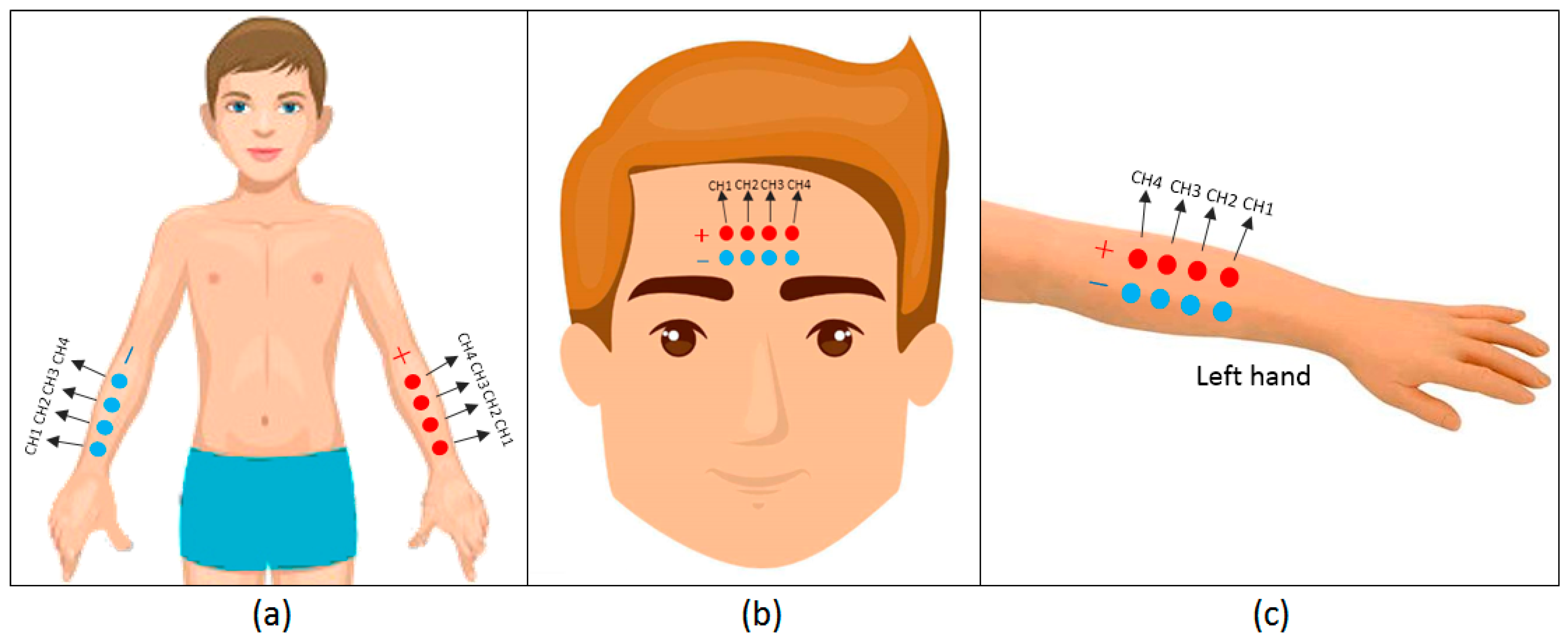
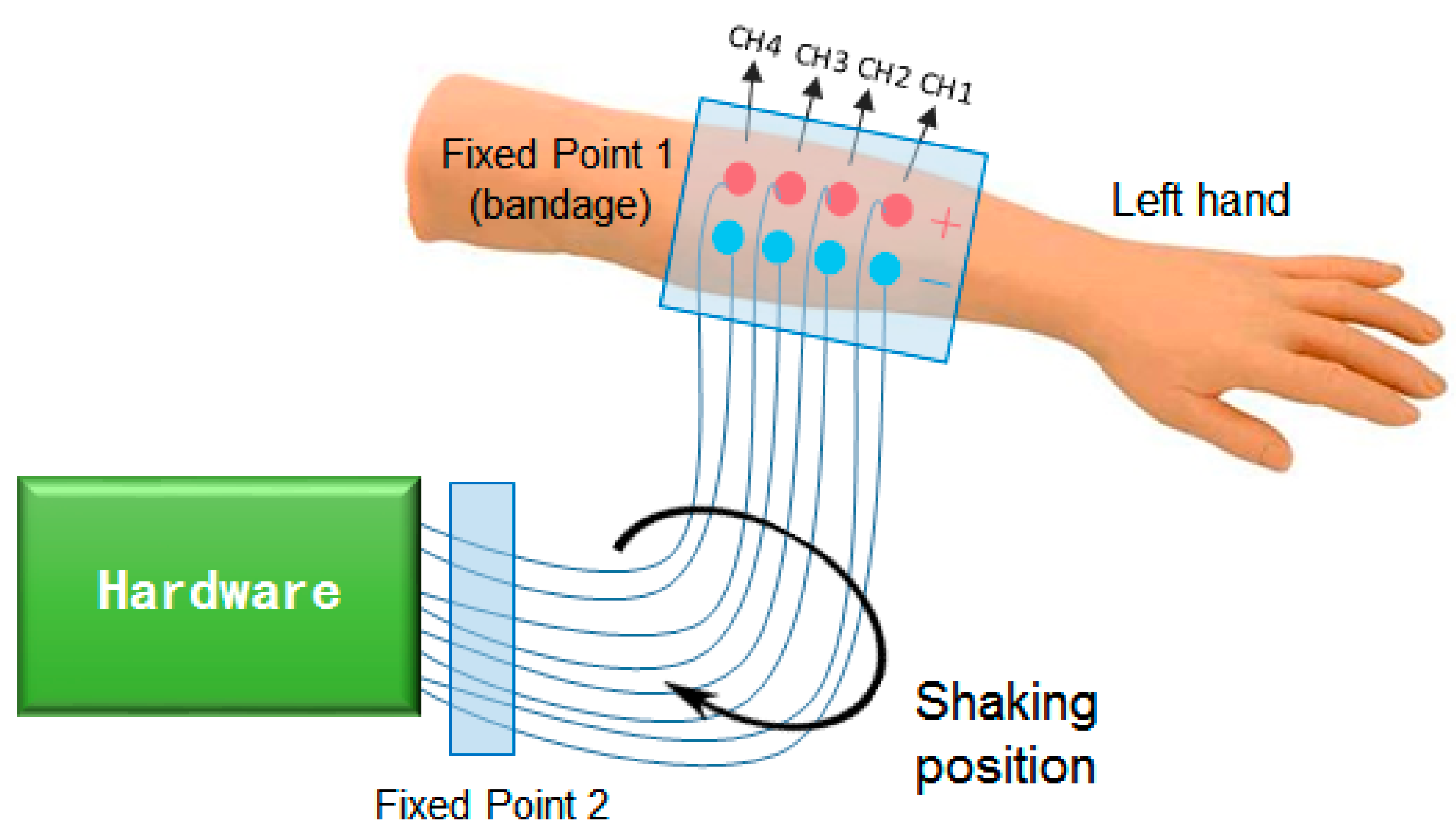
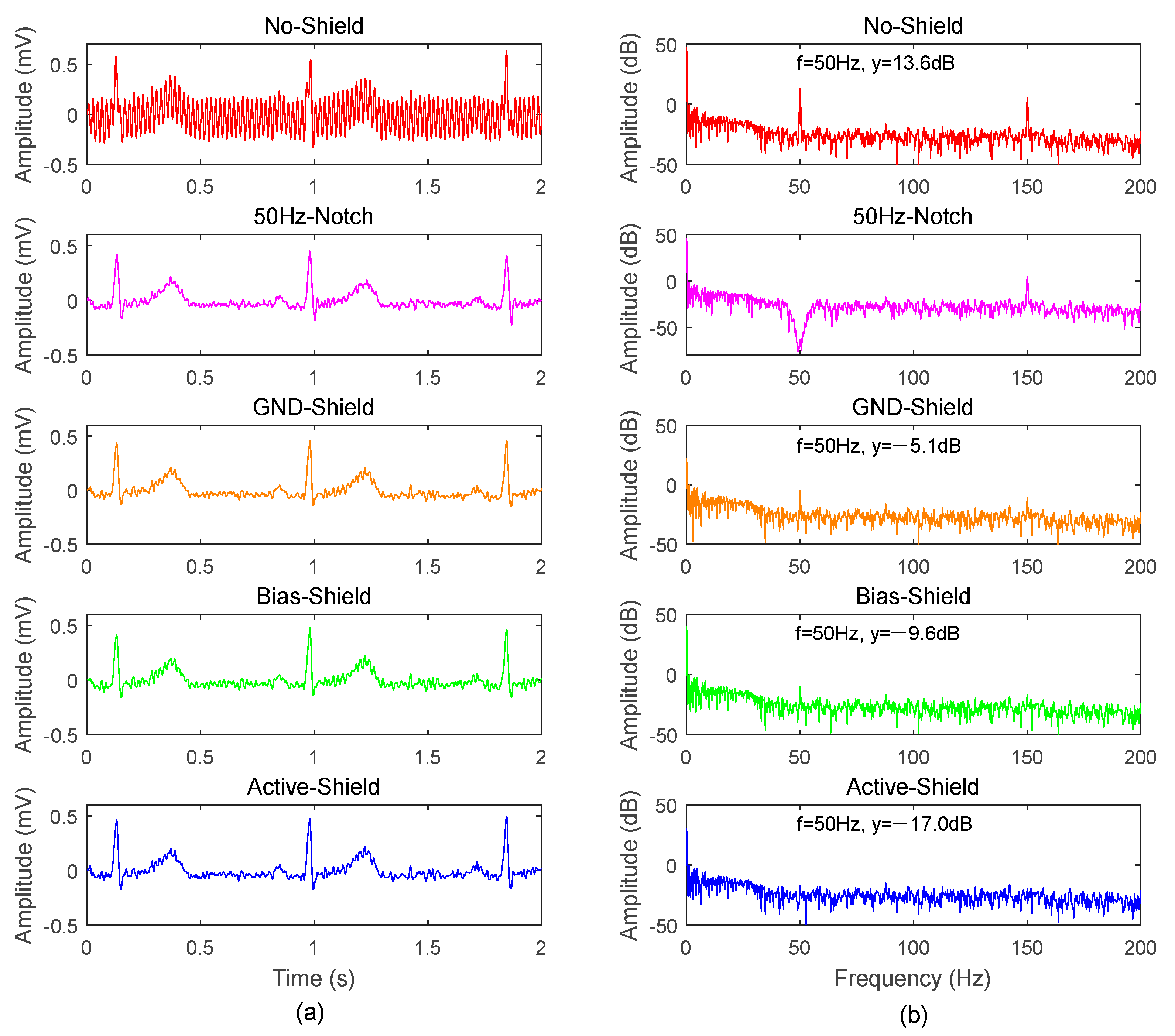
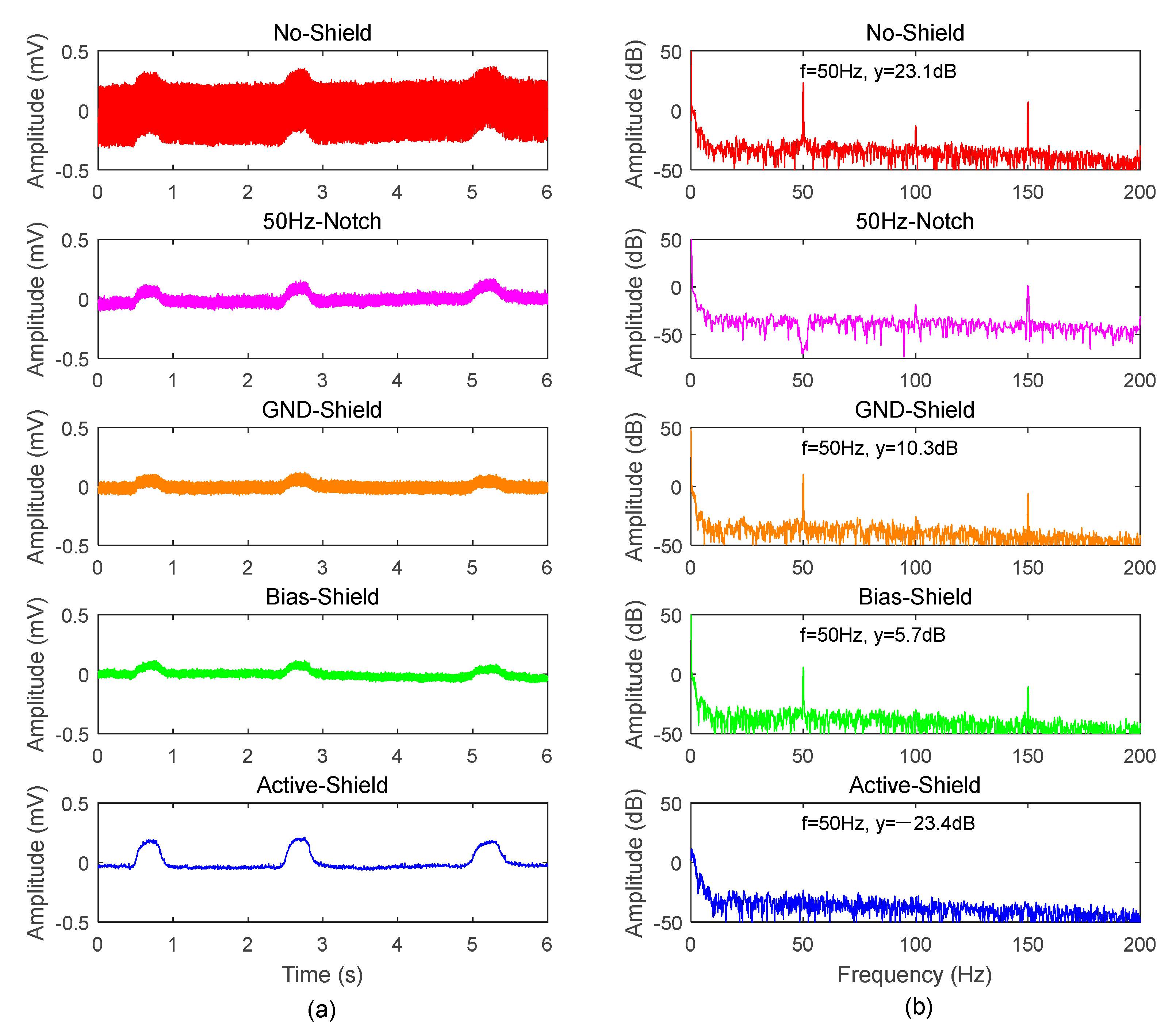
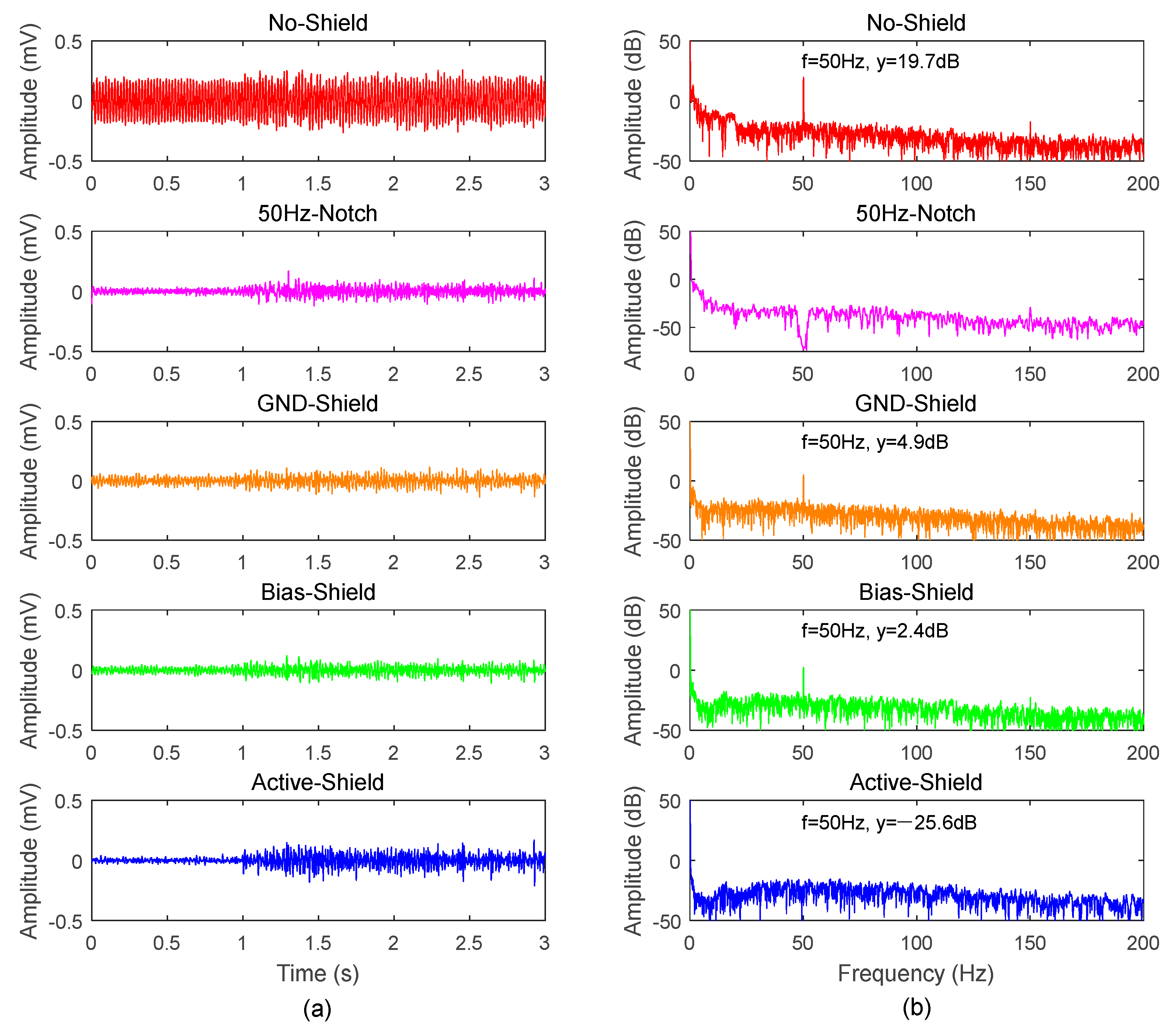
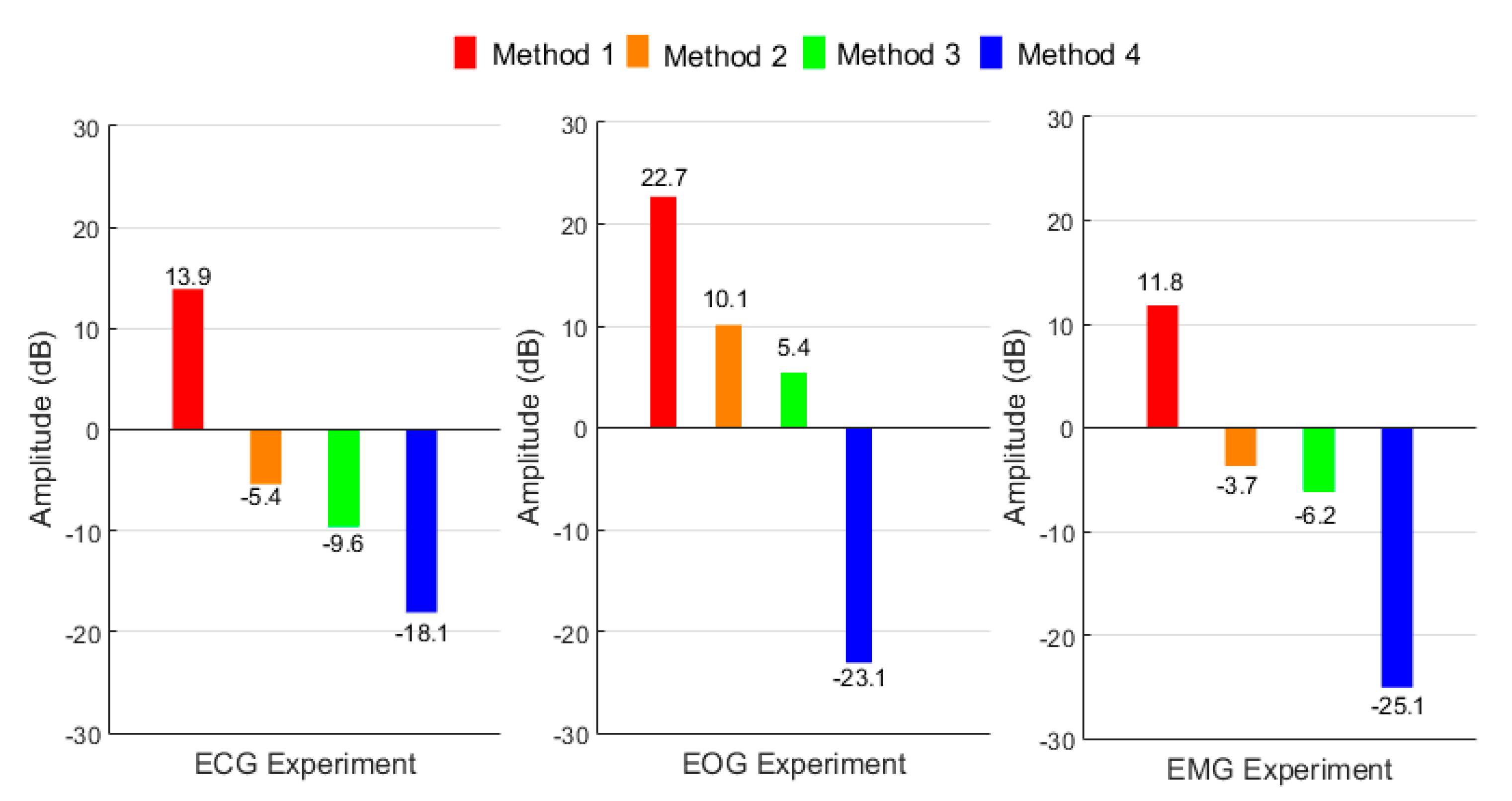

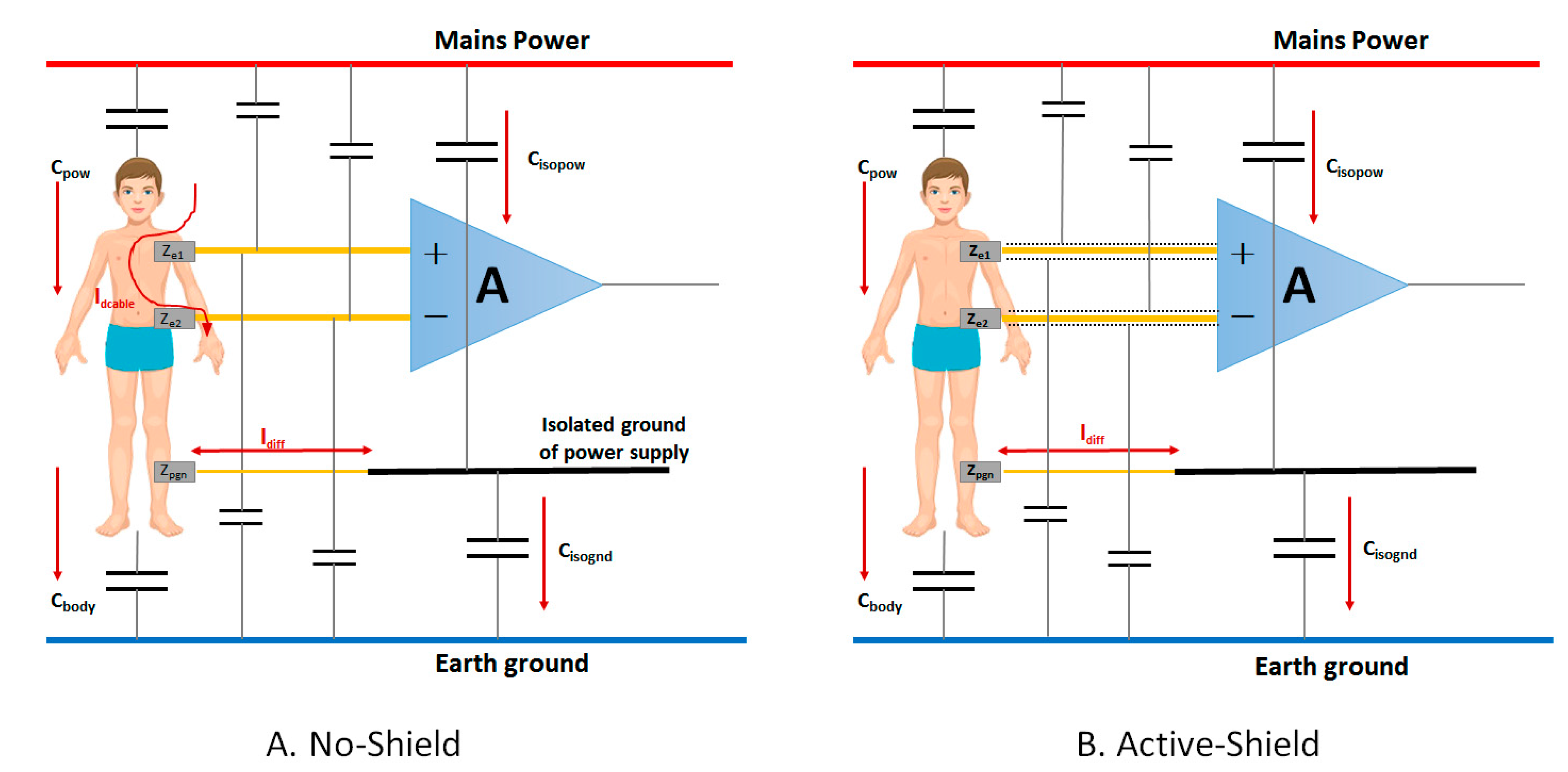
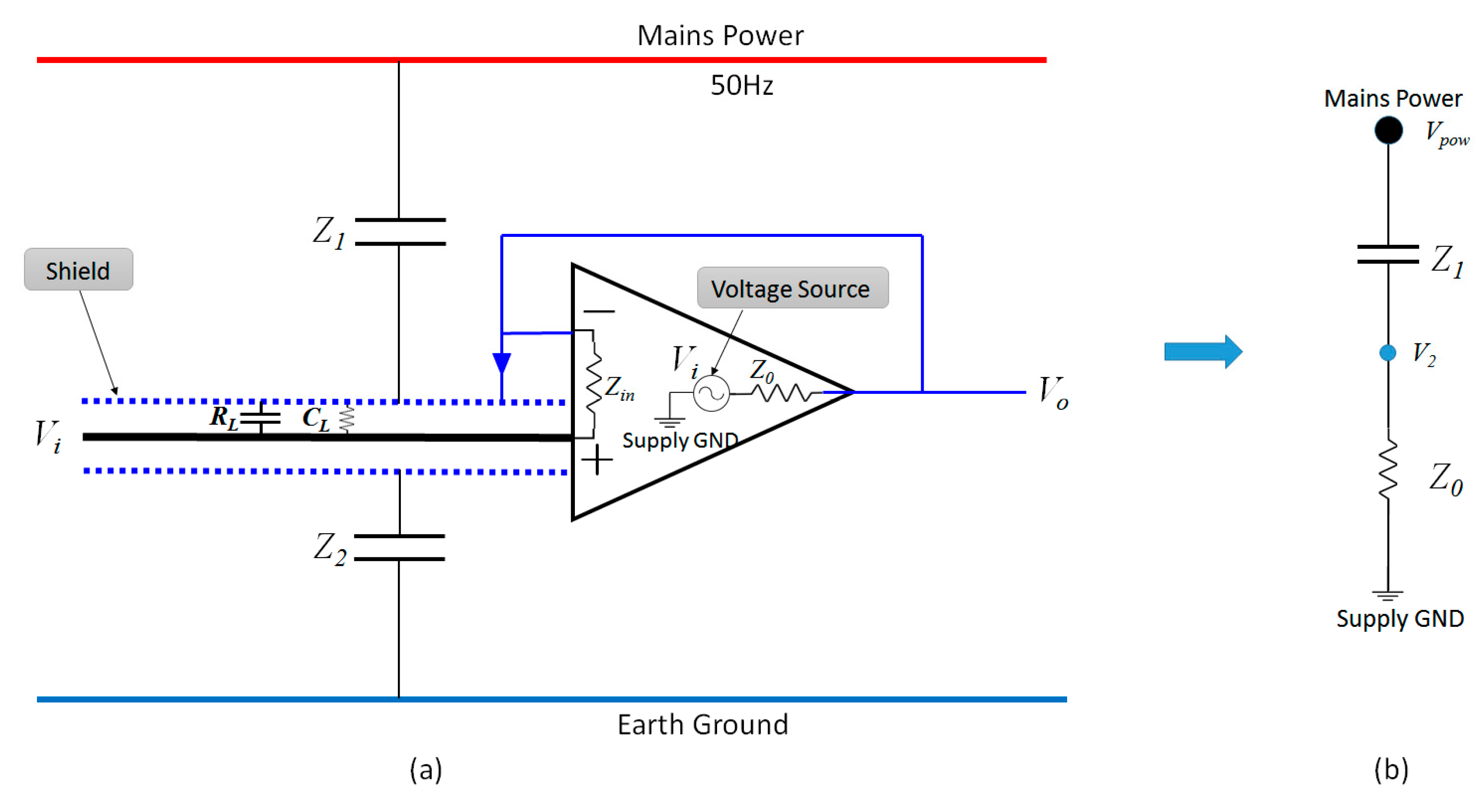

| M1–M2 (dB) | M1–M3 (dB) | M1–M4 (dB) | |
|---|---|---|---|
| ECG Experiment | 19.3 | 23.5 | 32.0 |
| EOG Experiment | 12.6 | 17.3 | 45.8 |
| EMG Experiment | 15.5 | 18.0 | 36.9 |
© 2018 by the authors. Licensee MDPI, Basel, Switzerland. This article is an open access article distributed under the terms and conditions of the Creative Commons Attribution (CC BY) license (http://creativecommons.org/licenses/by/4.0/).
Share and Cite
Jiang, Y.; Samuel, O.W.; Liu, X.; Wang, X.; Idowu, P.O.; Li, P.; Chen, F.; Zhu, M.; Geng, Y.; Wu, F.; et al. Effective Biopotential Signal Acquisition: Comparison of Different Shielded Drive Technologies. Appl. Sci. 2018, 8, 276. https://doi.org/10.3390/app8020276
Jiang Y, Samuel OW, Liu X, Wang X, Idowu PO, Li P, Chen F, Zhu M, Geng Y, Wu F, et al. Effective Biopotential Signal Acquisition: Comparison of Different Shielded Drive Technologies. Applied Sciences. 2018; 8(2):276. https://doi.org/10.3390/app8020276
Chicago/Turabian StyleJiang, Yanbing, Oluwarotimi Williams Samuel, Xueyu Liu, Xin Wang, Paul Oluwagbenga Idowu, Peng Li, Fei Chen, Mingxing Zhu, Yanjuan Geng, Fengxia Wu, and et al. 2018. "Effective Biopotential Signal Acquisition: Comparison of Different Shielded Drive Technologies" Applied Sciences 8, no. 2: 276. https://doi.org/10.3390/app8020276






